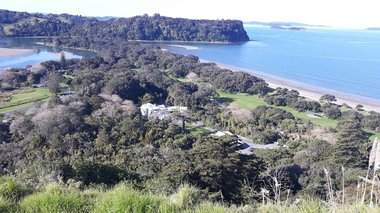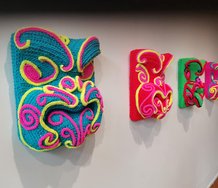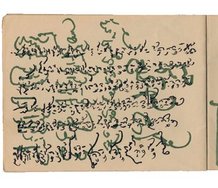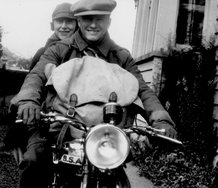Scott Hamilton – 4 October, 2020
It is the tension between form and formlessness, and the appearance and disappearance of figuration into abstract expanses of wood, that makes traditional Polynesian sculpture so powerful. When we look at these sculptures, or at the carving Thompson made for Wenderholm, we have the sense that the figures we see have only just emerged, are somehow still emerging, from hiding places in the wood.
EyeContact Essay #40
The recent closures of Auckland’s galleries made me look for the first time at some of the city’s finest artworks. As I took my kids, who had been noisily liberated from their school, for walks in forests and along beaches, I noticed sculptures and murals and installations that had been invisible to me in my pre-plague, gallery-going life.
Wenderholm is one of Auckland’s most popular parks. Even in autumn, its beach is often given over to sunbathers and cricketers. When we visited a group of young Sikh men were playing tippity cricket; at the non-strikers’ end, an umpire leaned sternly over a full set of stumps and bails. When the tide went out, parties of sunbathers rose, and splashed their way towards Mahurangi Rock, whose steep slopes rise thirty feet into the air. As they circled Mahurangi with white towels on their backs, the visitors resembled shawled pilgrims venerating Mecca’s Black Stone.
Smoke flew from the groves of arthritic pohutakawa behind the beach: a family was barbecuing the snapper and octopus they had caught in the nearby estuary of the Puhoi River. Beside a shingle path a woman with a diamond face mask was taking photographs of Couldrey House, the Victorian mansion-cum-museum that rises behind screens of roses in the centre of the park.
Beyond Couldrey House, Wenderholm changes. Lawns turn to swamp; roses become manuka and toi toi; the ancient peak of Maungatauhoro rises. As we climbed Maungatauhoro, thousands of shell fragments crackled under our jandals. Some of them had oozed from middens; others were strewn, centuries ago, to make the footsteps of approaching warriors audible.
The pa on the upper slopes of Maungatauhoro is called Te Kakahu. Once its ditches were palisaded, so that they resembled bared fangs. Now they are toothless gums, flecked with fungus. Rata vines were the barbed wire of Aotearoan battlefields, and they were spread over Maungatauhoro to slow attackers. Now vines wrap themselves protectively around the hill’s surviving trees—stout puriri, with their moth tunnels the width of bullet holes, and nikau palms as green as pounamu.
An old, half-empty reservoir sits near the top of Maungatauhoro. Leaves raft its stale green water, so that it looks like one of the abandoned swimming pools that JG Ballard made into symbols of the demise of Western civilisation. The hill’s summit is a ridge. A party of coastwatchers camped here during World War Two, waiting at dawn for Japanese submarines to float out of the mist alongside the islands of the Hauraki Gulf.
For centuries two small iwi, Ngati Rongo and Te Kawerau a Maki, occupied Maungatauhoro and its environs. Te Kawerau a Maki eventually migrated south, into the Waitakere Ranges; Ngati Rongo remained. In 1825 Hongi Hika brought his army of muskets down into Tamaki Makarau, through the rohe of Ngati Rongo. The local rangatira Murupaenga confronted Hika’s men with only a stone patu. Murupaenga died skirmishing in the Mahurangi River, which flows into the sea a few kilometres north of Maungatauhoro. He is buried on the hill, along with many other tupuna.
The Auckland Regional Council acquired Wenderholm in 1965. Early this century, when they were establishing a network of paths around the park, council planners asked tohunga whakairo Whare Joseph Thompson to carve a memorial to the place’s ancient inhabitants.
Thompson placed his sculpture behind Couldrey House, at the spot where the coastal zone of Wenderholm gives way to swamp and hill and bush. Thompson was born in Whangarei in 1972. He has Nga Puhi and Ngati Whatua ancestors, and trained in the nineties at Rotorua’s Waiariki Polytechnic.
Thompson possesses a minimalist’s sense of how much of his wood to carve and how much to leave unmarked, and a brutalist’s awareness of the sensuality that unadorned material can attain. The faces on his Wenderholm pou are a few deep cuts. They are bold yet enigmatic, like hieroglyphs. The figure on the front side of the sculpture has a block-like body, but a face with wide eyes and a cave-like mouth. Two smaller beings shelter in a hollow in his back. Thompson has left large expanses of wood uncut. They are faintly rippled, like the surface of a mature river.
In his great book The Coming of the Maori, Te Rangi Hiroa/Sir Peter Buck remarked, with an air of exasperation, on the supposed neglect of certain physical features by the carvers of Aotearoa. Buck regretted the ‘shapeless expansions of the lower ends of the legs’ in many Maori carvings, and the way arms could melt into torsos.
But it is the tension between form and formlessness, and the appearance and disappearance of figuration into abstract expanses of wood, that makes traditional Polynesian sculpture so powerful. When we look at these sculptures, or at the carving Thompson made for Wenderholm, we have the sense that the figures we see have only just emerged, are somehow still emerging, from hiding places in the wood. (1)
Although I had missed Thompson’s sculpture during previous visits to Wenderholm, I had seen a pou he carved in Tauranga in 2014, to mark the one hundred and fiftieth anniversary of the Battle of Gate Pa, when thirty-one British and colonial soldiers died after charging Maori trenches and bunkers. Thompson’s pou stands five metres high, and features a likeness of General Duncan Cameron, the elderly, saturnine commander of the British Army that invaded Tawhiao’s Waikato Kingdom in the winter of 1863.
Cameron did not like the bellicose Governor George Grey, and doubted the need for the war he had been told to wage. Cameron’s troops advanced only slowly through the swamps and puriri forests of South Auckland, and he was eventually given the nickname ‘the lame seagull’ for his perceived lethargy. But Cameron turned the first conventional battle of the war in his favour, by leading his men in a charge along the Koheroa Ridge, high above the Waikato River just south of present-day Mercer, and capturing several hastily evacuated Maori trenches. Cameron may have been a disillusioned soldier, but he was willing to die in a ditch for the cause he did not believe in.
Thompson gave Cameron the same dour blue uniform as his rank and file soldiers. Buttons rather than medals shine on his chest. His muttonchopped face is glum. His stomach bulges like an overloaded kitbag. A tall halyards presses down into his head, puncturing the naturalism of the portrait, and reminding us what a daring artist Thompson is.
Cameron seems to grimace under the black pou Pakeha balanced on his temple. Perhaps Thompson is trying to suggest that the general was, like the victims of his army, imprisoned and oppressed by history, by the abstract and inscrutable laws of empires and economics. Or perhaps the halyard is intended to remind us of the naval vessels that sat anchored in Tauranga harbour through 1864, disgorging troops and cannons and clergymen. The halyard surely hints at Cameron’s status as an alien in Aotearoa. He arrived in 1859; he left, after finally resigning his post, in 1865. If the Maori who defended Gate Pa were tangata whenua, then the attackers were people of the seas, and distant seas at that.
Last June Thompson unveiled an even more audacious work at The Elms, a nineteenth century mission station in the centre of Tauranga that is nowadays popular with tourists and with wedding parties. The Elms sits on land confiscated after the Waikato War, and in 2019 Tauranga’s city council voted to hand it to a Maori trust. More than four hundred Pakeha inhabitants of the city made written submissions against the decision; their words were suffused with the racial supremacism of the nineteenth century. Dissident councillor Margaret Murray-Benge sided with the angry Pakeha, saying that Maori ‘couldn’t be trusted’ to own the Elms, and warning that they would eventually ‘demand every piece of land’ in Tauranga.
Thompson’s carving for The Elms might be considered an attempt to mediate, at least symbolically, between Tauranga’s Maori and Pakeha communities. He has created a pavillion with a slanted roof, where visitors to the Elms can gather. On the structure’s pou Thompson has let a series of Pakeha images—the heads of missionaries Alfred and Charlotte Brown, six Celtic dragons, a Celtic cross—emerge from a matrix of traditional Maori patterns derived from flax weaving.
Because of their context, Thompson’s dragons seem about to morph into the taniwha that slither and seethe on marae around Aotearoa. The creatures made me think of the strange ‘Saurian monster’ that panicked the Pakeha soldier-settlers in the Waikato of the 1880s. The Waikato’s monster sometimes resembled a huge lizard, and at other times had long, black, shaggy hair. It always boasted huge jaws and jagged teeth.
Newspapers blamed the monster for attacking sheep and upsetting canoes; bands of settlers hunted it, carrying the guns they had recently aimed at Maori. Some papers blamed the Waikato’s indigenous people for the exotic creature: they talked of parties of Maori travelling to Australia, returning with alligator eggs, and leaving those eggs on the banks of the Waikato to hatch. The fact that there are no alligators in Australia only heightened the surrealism of the ‘monster scare’.
The monster of the nineteenth century was arguably a manifestation of the fears of the Pakeha settlers of a strange and stolen land. Will Thompson’s dragons be greeted with fear and disgust or with sympathy, by the unsettled Pakeha of twenty-first century Tauranga?
Scott Hamilton
(1) I once heard Visesio Siasau, who has trained in both Tongan and Maori carving traditions, tell an audience about his journeys into forests in search of raw material. The trees, he explained, were active collaborators in his work. He searched the ranks of ironwoods and totara, certain that the patterns he would carve were already, in some sense, waiting for him deep in the trunks of certain trees. Form comes from the formless, in the same way that life seeps and bubbles and leaps from Te Korekore-‘Uli ‘Uli Va, the fertile void that persists alongside and behind the Polynesian universe.





 Advertising in this column
Advertising in this column Two Rooms presents a program of residencies and projects
Two Rooms presents a program of residencies and projects



This Discussion has 0 comments.
Comment
Participate
Register to Participate.
Sign in
Sign in to an existing account.